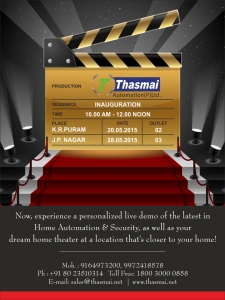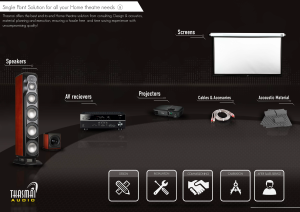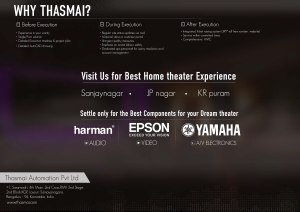Isn’t your screen is just a flat surface? Why spend money on something as basic as a screen when a cloth or a blank wall will do just fine? The answer is No & No!
The screen is usually made of material that is designed to reflect light back to you, whereas a wall has imperfect finish and a rugged coarseness, which although not easily visible to the naked eye can scatter the light all over the room and destroys the image quality and contrast. Also, it is not adept at dealing with Hot spotting (the term for a bright light to be shown on some parts and noticeably lesser light on other parts of the surface), side angle viewing or off axis viewing (where the display is not at an angle to facilitate best visual performance).
Now that we’ve decided that buying a screen makes sense, let’s look at the fine details that make up your dream home theater experience.
Fixed or Retractable: Fixed screens offer a better surface for viewing, in addition to being slightly less expensive and easier to install than retractable screens. Retractable screens (where the screen can roll up when not needed) can offer flexibility to the room for other events or purposes, in addition to being supremely cool (Imagine rolling down 120 inches of screen with your remote control, bet your friends hate you for that!)
Size & Distance: A screen size between 90-120” should accommodate most viewing needs, in addition to nicely fitting in normal sized rooms. A wall that is more than 8 feet in height, along with being 10-12 feet wide should be able to house most screens.
Due to the extremely image rich nature of today’s content (your 1080P can house over 2 million pixels), it is also important to maintain a minimum distance to the screen to enjoy the picture as a whole. The minimum recommended distance would vary according to the dimensions of the room, the screen size and other factors. Best option is to let a Home theatre expert set this up for you to have the most optimal experience.
Aspect Ratio: The aspect ratios (proportion between the width and height) are not standard across media, for example an IMAX format uses 1.43:1, and most cinemas now use 2.40:1, while TV programs stick with 4:3. If you primary intend to watch TV (Sports/Videogames), then we would recommend a 4:3, for movies the default aspect is the 2.40:1.
Other Things to remember
- Make sure your screen is acoustically transparent (i.e. the main speakers can be placed behind the screen, like in cinema theatres)
- Most people choose White as the color of the screen, but if you can also opt for Grey or Black depending on the amount of light present in your room. If you plan a normal room with lot of natural lights, black screens can be better than plain white screens to view pictures.
Follow Thasmai Automation’s ongoing series on Home theatres in our blog, check www.thasmai.net for more updates. Visit our dream Home theater experience zones in Bangalore to get a first hand feel.






